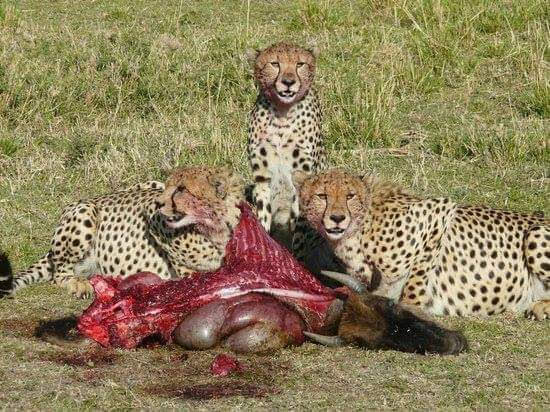Areas of Interest:
Samburu, Lake Baringo, Lake Bogoria, Lake Nakuru National Park, Lerochi Plateau, Great Rift Valley, Maasai Mara Game Reserve, Great Wildebeest Migration (Seasonal).
Activity: Game Viewing, Camping, Scenery, Trekking, Photography, Culture, and Bird Watching
Day 1 – Samburu
Depart Nairobi in the morning heading north via the shoulder of Africa’s second largest mountain, Mt Kenya to the Samburu Game Reserve. Accommodation in our semi-permanent campsite is beautifully set under a canopy of trees or we may pitch tents on the edge of the Ewaso Nyiro (meaning Brown in Samburu) River.
Cold showers are available which are amazingly refreshing in the hot, dusty climate. Dinner and overnight camping.
Day 2 – Samburu
A day spent game viewing in the park appreciating the diverse landscape and variety of animal species. Samburu is part of a lava plain that includes a diverse landscape of thorn scrub, red dirt, dried river beds, broken volcanic rock, steep hills, and rocky outcroppings.
The region is home to the uncommon Grevy’s zebra with huge fury ears, gerenuk antelope standing on hind legs to feed, Somali ostriches with distinct blue legs, and the shy Oryx.
Elephants and crocodiles are guaranteed sightings, and excellent bird watching with numerous varieties of weaverbirds and the martial eagle. Leopard sighting is also a special feature here. . Dinner and overnight camping.
Day 3 – Baringo
Depart in the early morning across the scenic Lerochi Plateau (with lunch en route) towards Lake Baringo, arriving at this freshwater lake in the late afternoon, we enjoy an evening boat ride in search of hippos, crocodiles, fish eagles, and a variety of other birds.
Lake Baringo is the most Northerly of Kenya’s small Rift Valley lakes; creased with papyrus and a well-developed acacia forest. Hippos, crocodiles, and monitor lizards are effortlessly seen from the shore, as is a magnificent display of water birds.
This is Kenya’s bird-watching center with over 1200 different species native to the country and more than 450 sighted here. A bird watcher’s haven but beware, this is malaria land so it’s best to come prepared with plenty of mosquito repellent!
Day 4 – Lake Nakuru
A 30km drive south to the spectacular Lake Bogoria with hot springs and geysers being the main attractions. The lake has been called ‘the new home of the flamingo’ with a nomad population of up to two million birds. Lunch and then proceed for an afternoon game drive at the Lake Nakuru National Park.
This small park (180 sq km) is home to warthogs, waterbuck, buffaloes, reedbucks, and the occasional leopard. White and black rhinos were introduced to the park some years ago and you will find white rhino at the southern end.
The park has also retained its reputation as an ornithologist’s delight with more than 400 species of bird found here. We spend the night at a campsite just outside of town.
Day 5 – Masai Mara
Heading further south towards Narok, we proceed towards our permanent campsite on the Talek River. Here we have stand-up tents with beds or small wood cabins for those after a touch more comfort. If all are occupied, we pitch tents.
On clear days, the Mara offers fantastic orange-tinted sunsets and you will definitely want to capture this moment while sipping on a sundowner back at our campsite. The Mara reserve is 1510 sq km of incredible wide-open landscapes and fertile riverine woodland following the looping meanders of the Mara and Talek rivers.
One glimpse is enough to explain its appeal; it is typical savannah, with a mass of amazing wildlife. Dinner and overnight camping.
Day 6 – Masai Mara
The day is spent exploring the Mara magic. Wherever you go in the Mara you will see a frequent amount of wildlife such as Masai giraffes, baboons, warthogs, bat-eared foxes, grey jackals, spotted hyenas, topis, impala, hartebeests, wildebeest. Elephants, buffaloes, zebras, and hippos also exist in great numbers.
It is common to see lions either basking after a heavy meal or surveying the plains for their next meal. Cheetahs and leopards are harder to spot but are still reasonably common.
The ultimate action here is without doubt the annual wildebeest exodus in July and August when millions of these grass eaters move north from the Serengeti in search of lusher grass before turning south again in October.
Balloon trips are an entirely outstanding way of seeing the savannah plains and the wildlife. Dinner and overnight camping.
Day 7 – Nairobi
We break camp and drive to Narok where Masai souvenirs can be bought, thereafter proceeding towards Nairobi. Drop off at your hotel

